Rooms Without Boundaries
|
Moderator Username: AdminPost Number: 84 Registered: Dec-03 | Introduction The home theater experience is about being immersed in the audio/visual experience -- maybe even letting go of reality for a few brief hours in an attempt to join the characters on the screen for a new adventure or experience. The technologies that are available now  to capture and manipulate images and sounds are continually pushing the envelope of challenging the senses into believing what they are experiencing. So why is it that we sometimes cannot entirely let go, what keeps us from making the journey into the world that the DVD is spinning for us? To blame any one thing would be ridiculous. There are many factors which contribute to a successful or not so successful theater experience. For the purposes of this article, we are going to assume that the temperature, lighting and the manners of your fellow viewers are contributing positively to your theater experience. We'll also assume that in the construction phase of your theater, attention was paid to 'external acoustic' issues such as disruptive sound transmissions into the theater and interference from the mechanical, electrical and plumbing systems. While we're at it, let's assume that the audio/video delivery system has been engineered and implemented appropriately. We want to focus on what is happening in your theater environment as speech, music and effects spill out of the 5-10 speakers placed around the room and what your brain must be thinking, as all of those sources and their reflections off the different wall and ceiling surfaces impinge on your ear canal in a symphony (or cacophony) of sounds... to capture and manipulate images and sounds are continually pushing the envelope of challenging the senses into believing what they are experiencing. So why is it that we sometimes cannot entirely let go, what keeps us from making the journey into the world that the DVD is spinning for us? To blame any one thing would be ridiculous. There are many factors which contribute to a successful or not so successful theater experience. For the purposes of this article, we are going to assume that the temperature, lighting and the manners of your fellow viewers are contributing positively to your theater experience. We'll also assume that in the construction phase of your theater, attention was paid to 'external acoustic' issues such as disruptive sound transmissions into the theater and interference from the mechanical, electrical and plumbing systems. While we're at it, let's assume that the audio/video delivery system has been engineered and implemented appropriately. We want to focus on what is happening in your theater environment as speech, music and effects spill out of the 5-10 speakers placed around the room and what your brain must be thinking, as all of those sources and their reflections off the different wall and ceiling surfaces impinge on your ear canal in a symphony (or cacophony) of sounds... The Missing Element The missing element in most home theaters is proper acoustical treatment. Why is the room so important? The reason is that sound 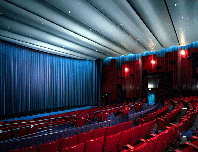 must eventually travel the acoustic path from the loudspeakers to our ears. The sound that we hear in a room is a combination of the direct sound from the speakers and the indirect reflections from the room surfaces and room contents. Indirect reflections can cause acoustic distortion, so that you end up listening to the room and not the intended soundtrack. Hence, reflection control is a central problem in creating rooms that allow a suspension of disbelief. In my experience, most soon-to-be home theater owners know that 'acoustic' panels are necessary components. This is mostly due to the fact that we see different types of wall and ceiling surfaces when we go to the large movie theaters and other performance spaces. We may not be sure what exactly they are, but we know that they are serving some purpose and that they should probably be there. Although it is beyond the scope of this article to go into detail, one thing we do know is that small rooms can cause a lot of problems when you force sounds into them (see Minimizing Acoustic Distortion in Home Theaters at ( must eventually travel the acoustic path from the loudspeakers to our ears. The sound that we hear in a room is a combination of the direct sound from the speakers and the indirect reflections from the room surfaces and room contents. Indirect reflections can cause acoustic distortion, so that you end up listening to the room and not the intended soundtrack. Hence, reflection control is a central problem in creating rooms that allow a suspension of disbelief. In my experience, most soon-to-be home theater owners know that 'acoustic' panels are necessary components. This is mostly due to the fact that we see different types of wall and ceiling surfaces when we go to the large movie theaters and other performance spaces. We may not be sure what exactly they are, but we know that they are serving some purpose and that they should probably be there. Although it is beyond the scope of this article to go into detail, one thing we do know is that small rooms can cause a lot of problems when you force sounds into them (see Minimizing Acoustic Distortion in Home Theaters at (The Solution Sound diffusion has been around for a long time.  In classic architecture, statuary, columns, relief or a variety of other ornamentation broke up sound waves and contributed to the experience by enveloping the listener in rich, even sound fields. While beautiful, these surfaces operated only at high frequencies. In the early eighties, Dr. Peter D'Antonio successfully implemented a new type of surface utilizing the number theoretic mathematics of Dr. Manfred Schroeder. This new surface neither absorbed In classic architecture, statuary, columns, relief or a variety of other ornamentation broke up sound waves and contributed to the experience by enveloping the listener in rich, even sound fields. While beautiful, these surfaces operated only at high frequencies. In the early eighties, Dr. Peter D'Antonio successfully implemented a new type of surface utilizing the number theoretic mathematics of Dr. Manfred Schroeder. This new surface neither absorbed  nor reflected sound. It uniformly scattered sound. Today, the research of Dr. D'Antonio and Dr. Trevor Cox has created a broad palette of sound diffusers that provide uniform scattering over any designable bandwidth. We are all familiar with the need to use air diffusers to provide uniform temperature, lighting diffusers to provide uniform luminosity and it should come as no surprise that we need a surface called a sound diffusor to provide uniform sound coverage. nor reflected sound. It uniformly scattered sound. Today, the research of Dr. D'Antonio and Dr. Trevor Cox has created a broad palette of sound diffusers that provide uniform scattering over any designable bandwidth. We are all familiar with the need to use air diffusers to provide uniform temperature, lighting diffusers to provide uniform luminosity and it should come as no surprise that we need a surface called a sound diffusor to provide uniform sound coverage.  Here is a breakdown of the diffusion tools that you now have available for your own Room without Boundaries. There are many new developments in diffuser technology coming down the pike, so for now, we'll stick with what you will be able to find readily available on the current market. Primitive Root Diffuser 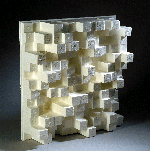 Designed utilizing modulated prime root number theory, the math shows us that the reflected energies will be equal in all the diffraction directions, yielding an even sound redistribution pattern as shown in the above right balloon plot. Its special performance feature is that it virtually eliminates the specular component of the incident sound wave. This means that in terms of creating a sense of spaciousness, while supporting imaging, there is no equal. 1D Quadratic Residue Diffusor 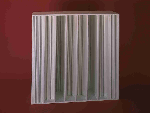 Designed utilizing quadratic residue number theory, the math shows us that there will be equal energy in the diffraction directions, which depend on the number of wells and how wide they are. The bandwidth depends on the deepest and narrowest wells. The scattered energy is in the form of a hemi-disc. The photo to the right shows an optimized quadratic residue diffusor, with nested components for increased performance. One of the most effective diffusers across the largest range of frequencies, these are most often used on the rear wall of theaters and listening rooms when the listening position is not close to the surface. 2D Quadratic Residue Diffuser 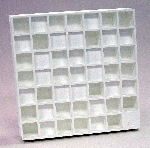 Designed utilizing modulated quadratic residue number theory, the performance of these units is similar to their 1D counterpart, only in 2D! The scattered energy is in the form of a hemi-sphere. Now available in a lightweight expanded polystyrene as well as molded gypsum and furniture grade wood units, this panel technology brings high performance in a low profile -- great for applications where headroom is at a premium. Binary Amplitude Grating  Designed utilizing optimal binary number sequences, this panel technology has revolutionized small room acoustic design. By placing a 5/32" diffusing template between the fabric and fiberglass of a common absorptive panel, an often overused and misused tool in many theaters and listening rooms, this hybrid panel diffuses high frequencies in 2 dimensions, while simultaneously absorbing low frequencies. The low frequency absorption is determined by the thickness of fiberglass behind the template and the depth of the air cavity behind the panel. When the surface is flat, these panels are typically 2-4" thick, which work well in rooms that cannot afford to lose many inches in its length or width dimensions. 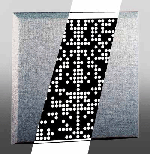 Also, because it is a hybrid surface, the listener can sit much closer to them without experiencing near field phasing effects. The template that separates the fabric from the fiberglass provides a diaphragmatic mass, which allows it to absorb frequencies much lower than a common fabric wrapped absorptive panel. The panels are now available in a curved profile, which enhances the diffusion and increases the imaging and spatial performance. Also, because it is a hybrid surface, the listener can sit much closer to them without experiencing near field phasing effects. The template that separates the fabric from the fiberglass provides a diaphragmatic mass, which allows it to absorb frequencies much lower than a common fabric wrapped absorptive panel. The panels are now available in a curved profile, which enhances the diffusion and increases the imaging and spatial performance. Geometric Diffusers 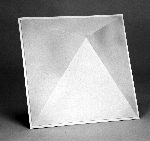 Units like the one shown at right have been around for many years. Other forms that they may take on are trapezoidal, barrel and globular shapes. Since these geometric forms are really re-directors of sound, rather than diffusers, they tend to work better in larger spaces, such as choral rooms, churches and band rehearsal rooms. As they are technically classified as sound redirectors rather than true sound diffusers, you do not find them often in small rooms. Breaking it all down Whether it is a fictional, historic or comical interpretation of the world, we are trying to put behind us for a few hours, it is hard to let go when there are constant reminders that we have never left the room. One of my biggest complaints in an untreated theater or one overly treated with absorptive material, and often low bandwidth absorptive material, is that despite the wonderful imagery on the screen and sonic perfection coming from the speakers, the sound of the room will not allow me to forget that it's small. If someone had several spotlights shining on you during the movie, wouldn't that detract from the visual experience? The room is basically 'shining' sonic spotlights on us, from every direction in an untreated room. In a poorly treated room, those with low performance absorptive panels, we are simply dimming the spotlights ever so slightly, which makes it a little more tolerable but still not environment that it should be. A properly treated room will remove the spotlights and allow the quality of the soundtrack, the speaker and the electronics to be fully realized. Without the boundaries, you could be anywhere... by Jeff Madison from RPG Jeff is the senior product application consultant in RPG's Home Theater Division. He spent his first years at RPG developing its computer modeling and acoustic testing capabilities. With a backround in music and engineering, he enjoys the challenges of both large and small spaces... and golf. For more information on RPG, please visit http://www.rpginc.com. There is an extensive library section with many technical articles on room acoustics if you care to delve more deeply into the subject. Also, please visit http://www.rivesaudio.com, who has provided this series of articles on acoustics. Rives Audio is the leading consulting and design group for small room acoustics and has an extensive resource section where you can learn more on acoustics as well. |
|
Ryanddd Unregistered guest | I recently read about a different product called a acoustical treatment called a room dampening panel. Can anyone please do a review and show pics? professionalaudiospeakersystems .com |
|
New member Username: ToyamorOntarioBahrain Post Number: 4 Registered: May-23 | This article highlights the crucial role of proper acoustical treatment in home theaters. The author emphasizes that sound diffusion is the missing element in most home theaters, as it helps control reflections and create a natural, immersive listening environment. By utilizing advanced sound diffusion technologies, such as primitive root diffusers, quadratic residue diffusers, binary amplitude gratings, and geometric diffusers, it is possible to achieve balanced room acoustics. These diffusers scatter sound energy evenly, enhancing spaciousness, imaging, and spatial performance. The author suggests that treating the room acoustically allows the viewer to fully experience the high-quality audio and visual elements without constant reminders of the room's limitations. Ultimately, a properly treated room creates an environment where one can truly escape reality and be transported anywhere. |
Main Forums
Today's Posts- Home Audio Forum
- Home Video Forum
- Home Theater Forum
- Car Audio Forum
- Accessories Forum
- All Forum Topics